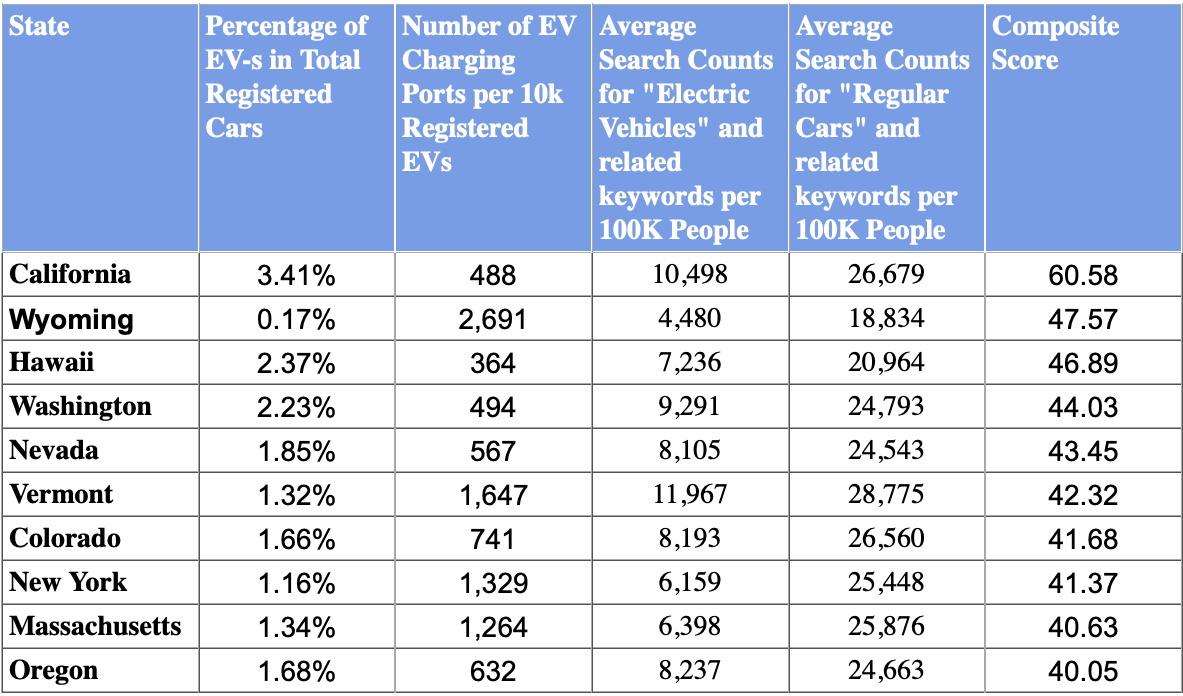New Data Reveals Where EV Adoption is Rising Fast — and Where it’s Not
A recent study by Bruning Law Firm evaluated each state's electric vehicle landscape by examining five key metrics: current EV market share, charging infrastructure adequacy, gasoline station density, consumer interest in electric vehicles, and interest in traditional vehicles. The weighted values were combined into a composite score ranging from 0-100, with higher scores indicating greater EV adoption progress and potential.

You can access the full research findings here
California ranks 1st with a composite score of 60, having the highest percentage of EVs in total registered cars, reaching 3.41%. With over 1.25 million electric vehicles, California has more EVs than the next nine states combined. The Golden State demonstrates strong consumer interest with 10,498 searches for electric vehicles per 100K people, second highest among all states.
Wyoming ranks 2nd with a score of 47, despite having only 1,100 registered EVs, the lowest total in the top 10. The state's exceptional performance is driven by its nation-leading charging infrastructure, with 2,691 charging ports per 10K EVs, over five times higher than California's density.
Hawaii ranks 3rd with a score of 46. Island life seems well-suited for electric vehicles, with Hawaii claiming the second-highest percentage of EV cars at 2.37% with 25,600 registered electric vehicles. Limited driving distances make range anxiety less of an issue, though the state has the fewest charging stations among top performers.
Washington comes in 4th with a score of 44, featuring the third-highest share of EVs among all registered vehicles at 2.23%, with over 152,000 electric cars on the road. The state shows strong consumer interest, recording 9,291 EV-related searches—the third highest nationwide. Its charging infrastructure is moderate, with 494 ports, nearly matching California’s in availability.
Nevada ranks 5th with a score of 43, achieving a balanced profile across metrics with 47,400 registered EVs representing 1.85% of all vehicles. The state features solid charging infrastructure with 567 ports, and strong consumer interest, placing it in the middle of the top 10 for each category while maintaining a low gas station density similar to California.
Vermont ranks 6th with a score of 42. Vermonters show the highest interest in electric vehicles of any state, searching for EV information nearly 12,000 times. This enthusiasm is supported by excellent charging infrastructure, giving Vermont's 7,800 electric vehicles plenty of places to power up. Interestingly, Vermont also maintains the most gas stations per capita among top states, supporting both vehicle types.
Colorado is 7th with a score of 41, showing balanced performance with 90,100 registered EVsrepresenting 1.66% of all vehicles. The state's charging infrastructure with 741 ports, and healthy consumer interest with 8,193 searches, fifth highest nationwide, indicate a well-developing EV ecosystem in this mountain state.
New York takes 8th place with a score of 41.37, featuring 131,300 registered EVs and a share of 1.16% compared to all registered vehicles. The state makes up for this with strong charging infrastructure, offering 1,329 ports—the fourth highest nationwide. Consumer interest is relatively low, with 6,159 EV-related searches.
Massachusetts comes in 9th with a score of 40. With 73,800 electric vehicles, Massachusetts offers impressive charging infrastructure that ranks among the nation's best. While Massachusetts residents still overwhelmingly prefer traditional vehicles (with over 90% of registered vehicles being conventional), EV owners enjoy excellent support through widespread charging options.
Oregon rounds out the top ten, with 64,400 registered EVs representing 1.68% of all vehicles. The state shows strong consumer interest with 8,237 searches, fourth highest, but relatively modest charging infrastructure with 632 ports.
Attorney AJ Bruning from Bruning Law Firm commented on the study: "The geographic disparity in electric vehicle adoption highlights both policy effectiveness and infrastructure challenges facing the transition to sustainable transportation. The persistent gap between interest in conventional and electric vehicles suggests that consumer education remains critical. As battery technology improves and more affordable EV models enter the market, charging infrastructure density will increasingly determine which regions successfully navigate the electric transition. States that proactively address this infrastructure requirement, rather than waiting for adoption to drive demand, may ultimately leapfrog current leaders.
Bruning Law Firm | https://www.bruninglegal.com/










